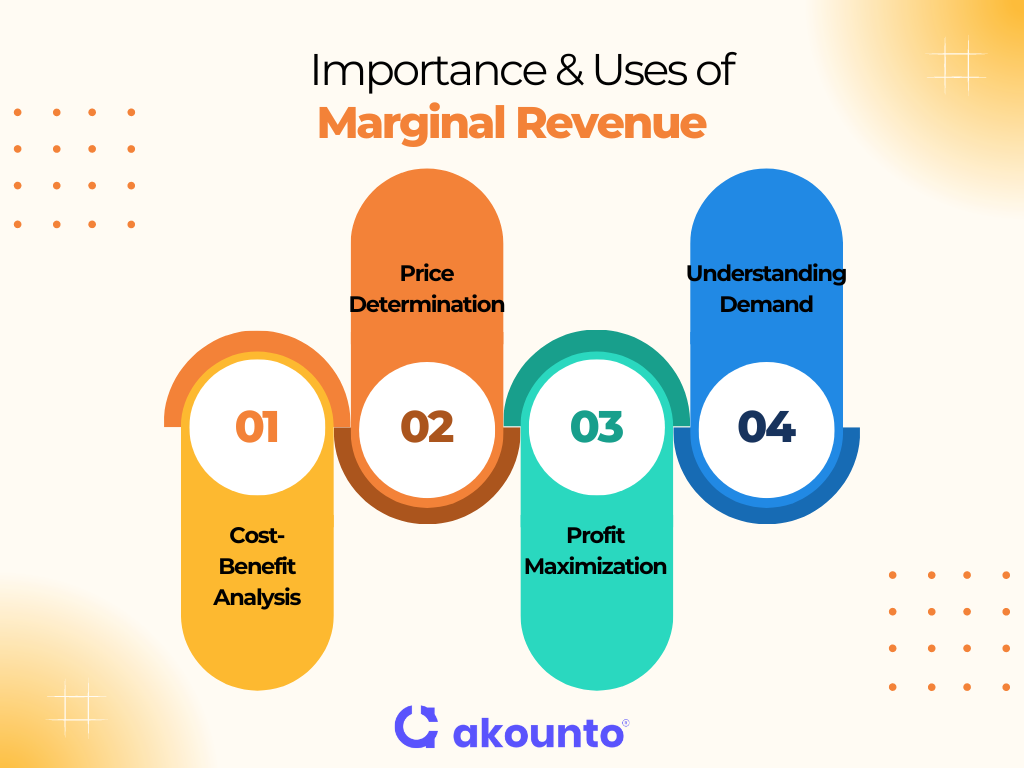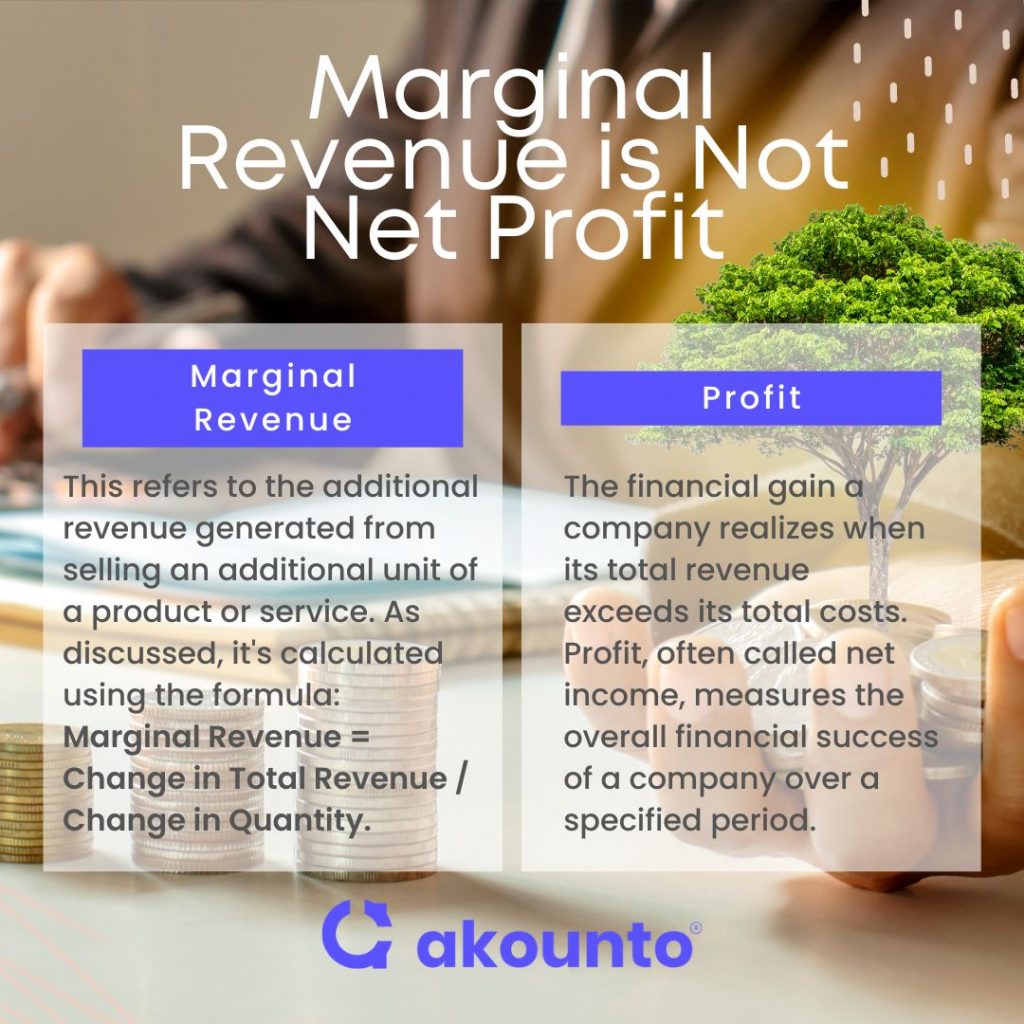What Is Marginal Revenue?
Marginal revenue is the additional revenue generated when a business sells one additional unit of a product or service.
Marginal revenue calculation allows small businesses to assess the financial implications of selling more units.
For example, if a small business sells 100 units of a good at a certain price and then sells 101 units at a slightly different price, the marginal revenue would be the change in total revenue resulting from selling that additional unit. This concept is central for making informed pricing, output, and profit maximization decisions.
Understanding the marginal revenue curve can also be of great value, which is a graphical representation depicting how marginal revenue changes with changes in quantity sold.
A marginal revenue curve is a visual tool that can help businesses anticipate changes in revenue as they increase or decrease the quantity of output.
The concept of marginal revenue is especially important in perfectly competitive markets where a business owner can sell additional units at the same price without affecting the market price. In such scenarios, the marginal revenue equals the market price.
It’s important to note that the scenario can be quite different in imperfect competition. For instance, when the market dictates the price, a company’s marginal revenue will decrease as they sell more units. It is because, to sell more units, the company may need to reduce its price, which can impact the average revenue.
Importance & Uses

The importance of marginal revenue cannot be overstated for entrepreneurs, small business owners, and freelancers. It plays a crucial role in shaping critical business decisions relating to production and pricing.
- Profit Maximization: Marginal revenue is instrumental in achieving profit maximization, a primary goal for any business. It helps businesses determine the optimal level of production. When marginal revenue exceeds marginal cost, a business can increase its profit by producing and selling more units. Conversely, when marginal revenue is less than marginal cost, businesses should cut back production to avoid losses.
- Price Determination: Marginal revenue is key to understanding how price changes affect total revenue. When a business increases the quantity sold, the total revenue will increase if the marginal revenue is positive. While if the marginal revenue is negative, total revenue decreases as the quantity sold increases. This understanding aids businesses in setting their prices efficiently.
- Understanding Demand: The marginal revenue curve mirrors the demand curve in a perfectly competitive market. By understanding marginal revenue, businesses can gauge consumer demand and strategize accordingly.
- Cost-Benefit Analysis: Marginal revenue is a significant part of the cost-benefit analysis. It helps businesses understand the revenue benefits of producing additional units versus the costs associated with producing these units.
By leveraging the understanding of marginal revenue, businesses can make data-driven decisions that help them achieve their financial objectives.
Calculate Marginal Revenue
Marginal Revenue Formula
Calculating marginal revenue involves a simple yet critical, which is pivotal for businesses in making informed decisions. The marginal revenue formula is:
Marginal Revenue (MR) = (Change in Total Revenue) / (Change in Quantity)
Explanation of the formula:
- Change in Total Revenue: is the total revenue difference from selling an additional unit of a product or service. You can calculate the total revenue by multiplying the number of goods sold by their respective price.
- Change in Quantity: This refers to the variation in the number of units sold, typically an increase of one unit, but it can vary depending on the situation.
Marginal revenue is computed by dividing the change in total revenue earned by the change in quantity sold. For example, if a company sells one additional unit and the total revenue increases by $20, the marginal revenue generated by that unit is $20.
The above-given formula applies to all types of markets – be it a perfectly competitive market or an imperfect competition scenario.
Interpretation
Maintaining a keen eye on the changes in total revenue and quantity will give businesses the insights necessary to understand their marginal revenue and, subsequently, chart more informed business strategies.
In certain situations, the increase in total quantity sold does not correspond to an increase in total revenue. This is where the concept of positive marginal revenue and negative marginal revenue comes into play.
For example, in the case of perfectly elastic demand, the company sells additional units at the same market price, leading to positive marginal revenue. However, when customer demand is less elastic, the company might need to lower the price to sell more units, which could lead to negative marginal revenue.
Numeric Example
To further illuminate the concept of marginal revenue, let’s look at a practical numeric example.
Let’s consider a small business that sells handmade candles. The table below illustrates how the quantity of candles sold impacts the total revenue:
| Quantity Sold | Total Revenue ($) |
| 0 | 0 |
| 1 | 20 |
| 2 | 38 |
| 3 | 54 |
| 4 | 68 |
| 5 | 80 |
To calculate marginal revenue, the change in total revenue and divided by the change in quantity.
For instance, when the business owner sells the first candle, the total revenue goes from $0 to $20. Therefore, the marginal revenue for the first candle is:
Marginal Revenue = Change in Total Revenue / Change in Quantity = ($20 – $0) / (1 – 0) = $20 / 1 = $20
Similarly, to calculate marginal revenue for the second candle:
Marginal Revenue = Change in Total Revenue / Change in Quantity = ($38 – $20) / (2 – 1) = $18 / 1 = $18
The marginal revenue decreases as more candles are sold due to the law of diminishing returns.
In economic theory, marginal revenue and marginal cost intersect at the point of profit maximization. The concept is represented graphically through the marginal revenue curve and the marginal cost curve. For instance, a rise in output sold might initially lead to more revenue, but only up to a certain point.
The law of diminishing returns states that each additional unit sold might decrease the total revenue, presenting a negative marginal revenue scenario. This is a crucial element in calculating marginal revenue and marginal costs.
Is Marginal Revenue the Same As Profit?

Although marginal revenue and profit are critical financial metrics for businesses, they differ. These two concepts represent distinct aspects of a company’s financial performance.
- Marginal Revenue: This refers to the additional revenue generated from selling an additional unit of a product or service. As discussed, it’s calculated using the formula: Marginal Revenue = Change in Total Revenue / Change in Quantity.
- Profit: the financial gain a company realizes when its total revenue exceeds its total costs. Profit, often called net income, measures the overall financial success of a company over a specified period.
Key Differences
- Concept: Marginal revenue focuses on revenue generated by selling additional units, while profit emphasizes the overall earnings after deducting all costs.
- Calculation: Calculating marginal revenue involves measuring the change in total revenue as a consequence of selling an additional unit. In contrast, calculating profit requires subtracting total costs from total revenues.
- Role in Decision Making: Businesses use marginal revenue to determine the revenue potential of selling more units, while profit information is used for broader decision-making, like setting strategic goals, determining budgets, and assessing the overall financial health of the enterprise.
Understanding marginal revenue and profit is essential for effective business management and strategic decision-making, especially in terms of production schedules and profit maximization.
The analysis of marginal revenue also includes concepts such as the average revenue curve and the marginal cost curve. For a perfectly competitive entity, the average revenue curve is a horizontal line because the firm can sell all units of output at the same price.
In comparison, the marginal cost curve often has a U shape due to costs beginning to rise as all product units produced, representing the law of diminishing returns.
Marginal Revenue vs. Marginal Benefit
While both important, marginal revenue and marginal benefit concepts have unique implications for business decisions.
| Marginal Revenue | Marginal Benefit | |
| Definition | The additional revenue a business generates by selling an additional unit of a product or service. | The additional satisfaction or utility a consumer receives from consuming an extra unit of a good or service. |
| Calculation | Change in Total Revenue / Change in Quantity | The difference in total benefit from the consumption of an additional unit. |
| Role in Decision Making | Businesses use marginal revenue to determine the revenue potential of selling more units. | Businesses and consumers use marginal benefit to make decisions about how much of a good or service to consume. |
| Relevance to | Pricing strategies, revenue optimization, production schedules, profit maximization. | Consumer demand, market price, cost benefit analysis. |
Marginal revenue and marginal benefit are interconnected in a market economy. When marginal revenue equals marginal benefit, the company is said to be operating at its most efficient level.
Perfectly competitive firms, guided by the principles of marginal analysis, balance marginal costs and benefits to optimize output and revenue. Furthermore, understanding consumer demand, which is depicted by the market demand curve, and comparing it with a company’s marginal revenue, helps firms decide the optimal production level.
Marginal Revenue vs. Marginal Cost
| Marginal Revenue | Marginal Cost | |
| Definition | The additional revenue generated by selling an additional unit of a product or service. | The additional cost incurred by producing and selling an extra unit of a product or service. |
| Calculation | Change in Total Revenue / Change in Quantity | Change in Total Cost / Change in Quantity Produced |
| Role in Decision Making | Businesses use marginal revenue to decide the optimal quantity of goods to sell. | Firms use marginal cost to decide the optimal level of output. Marginal cost guides businesses on when to stop or continue production. |
| Relevance to | Pricing strategies, revenue optimization, profit maximization, company’s marginal revenue. | Cost control, production schedules, profit maximization, cost benefit analysis. |
Taking an example of a scenario where an additional unit sold at a reduced price can lead to a change in revenue. Suppose the average price is $20, whereas to sell an additional unit, the price decreases to $18.
Consequently, marginal revenue measures the impact of the price reduction on total revenue. When plotted, this brings about an interesting interaction where the marginal revenue MR and marginal cost intersect, showing the most profitable quantity produced.
Conclusion
Marginal revenue is a significant concept that can help businesses to strategize pricing, output, and profit maximization. Businesses can accurately predict revenue changes and correspond to output quantity changes, allowing for efficient decision-making.
Understanding marginal revenue’s relationship with concepts like marginal cost and marginal benefit can facilitate effective cost control and demand analysis.
Akounto, an all-in-one accounting software, offers an intuitive dashboard where users can track all their business finances at a glance and generate deeper analysis at the touch of a button. For more information, visit our website.




